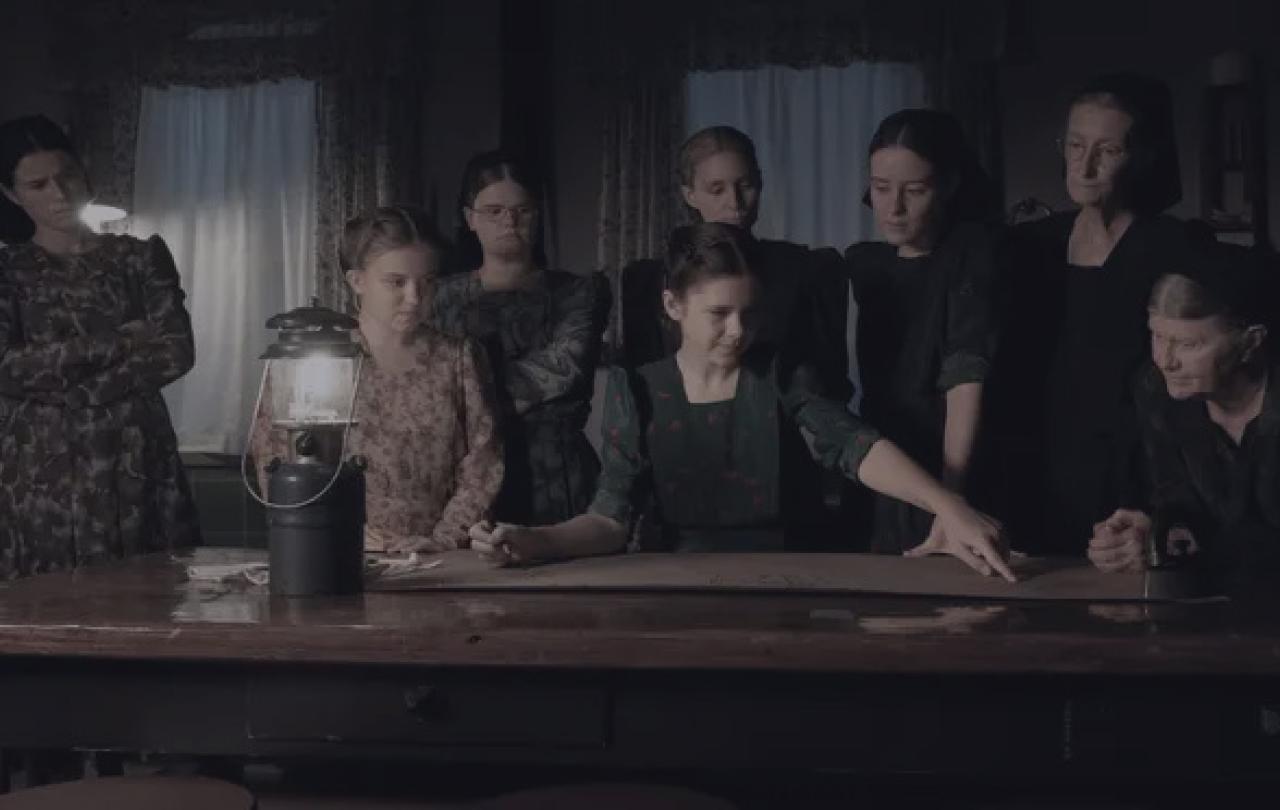
A trigger-warning to our readers: this article tackles the themes of sexual and physical abuse, which, for some readers, may make this piece a particularly hard one to read.
The title to this film could be so many things: women forgiving, women fighting, women growing, women shrinking, women believing, women doubting, women conserving, women demolishing. If you find yourself settling down to watch Sarah Polley’s masterful film, you’ll witness eight women from a Mennonite community in America do all of this, and infinitely more.
Women Talking will be unlike any film you’ve seen before.
In an eerily context-less setting, the women of an isolated religious community come to the traumatic realisation that they have been abused, violently and systemically, for many years. This abuse has been at the hands of the men in their radically patriarchal community: their fathers, their brothers, their uncles, their sons. Catching one of these men red-handed, the women realise that what they had long been manipulated into thinking was either their own irrational imaginations or ghostly/demonic encounters, was actually sexual abuse perpetrated by the men they had shared their entire existence with. The men they had raised. The men who had raised them.
Based on the acclaimed novel by Miriam Toews and inspired by a harrowing true story, the Oscar-winning script offers us a front row seat to the falling apart of an entire reality as these women begin to unravel all that they know to be true.
Do they stay and forgive the men? Do they stay and fight to the (literal) death? Or do they leave and make a new home for themselves in an outside world they know nothing of? This is the question that drives the narrative of the film as eight representatives from three different families are tasked with coming to a decision, this is the conundrum that has the women talking.
'This film tackles a truly traumatic subject with the utmost care, it is as empathetic as it is empowering.'
With a sense of specific time and place that is only given one opportunity to interrupt the narrative (in the form of a call for the residents to be counted in the 2010 census), there is a distinct sense that this story is tragically universal in its nature. As countless critics have observed, this film tackles a truly traumatic subject with the utmost care, it is as empathetic as it is empowering. It does not minimise the atrocities that these women and girls have experienced, nor does it sensationalise them. Through the immensely talented ensemble cast, Director, Sarah Polley has curated a spectrum of raw and complex emotion - brutal honesty, righteous anger, utter despair and rebellious hope are weaved together to create a tapestry of reaction.
The complexity and care with which this story is told is a gift to the women who inspired the film, and to the women who will watch it.
Audiences watch as the powerful rage of Salome (played by The Crown’s Claire Foy) is countered by the defiant gentleness of Ona (Rooney Mara), while the loud terror of Mariche (Jessie Buckley) is quelled by the silent care of Melvin (a transgender character played by August Winter). And, all the while, not one reaction is judged. Every woman is given the right to her own natural response, and the right to have that response shift and stretch and adjust. The dignity and love that flows out of this conversation is somewhat of a masterclass in the beginnings of healing and the liberation that follows.
And yet, the film has even more to offer its audiences, there’s yet another question that is written into the rock of Women Talking, one which was articulated by the director herself -
‘What does it mean to be true to your faith? What does it mean to get rid of the structures that have sprung up around your faith, that are insidious and corrupting?’
It is utterly fascinating: the women are determined to rid themselves, one way or another, of the men who have hurt them so deeply, but they refuse to be separated from the God whose name has been manipulatively enacted in the process. Where we are so used to the entanglement of God and the people who wrongfully use him as a means to an awful end, these women seem to demonstrate quite the opposite. And what’s more striking is that they do so, not out of obligation or duty, but out of pure love and hope.
When the women speak of earthly things, there is a heaviness to their voices. When they speak of God, their words feel light.
We see them recite the Bible in moments of overwhelm, meditate on it in moments of decision-making, pray it in moments of panic, and refer to it in moments of relief. It is their faith that fuels their rebellion, it is their belief in God that informs their desire for more. A verse from the Bible is ultimately the catalyst for their decision to leave, as they choose to re-build their lives on ‘whatever is true, whatever is noble, whatever is right, whatever is pure, whatever is lovely, whatever is admirable’. It seems that if the oppressors wanted these women to believe that they were inherently less than, they simply should not have introduced them to a God who tells them differently.
One of the most powerful monologues comes from a bruised and bleeding Mariche towards the end of the film. She says,
‘We have decided that we want, that we are entitled to, three things… we want our children to be safe, we want to be steadfast in our faith, and we want to think’.
Her weighty words are responded to with tears and with a song. The sound of the women singing the words ‘nearer my God to thee, nearer to thee’ becomes the soundtrack to them packing up their lives as they leave familiarity in search of freedom, a freedom which is not intended to create distance between them and God, but to bring them nearer to each other.
To watch faith flow from the wounded is humbling. To see the complexities between God and hurt play out in this film is captivating. It feels compellingly honest, and messy, and real.
The Oscar win and the endless five star-reviews are sufficient evidence of the power of Sarah Polley’s Women Talking. But deeper evidence may also be found in the profound catharsis felt by those viewers who, in varying contexts, are trying to disentangle their faith from their hurt, or perhaps the curiosity of those who are left wondering what kind of a faith would ever be worth such an endeavour.





